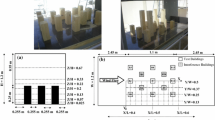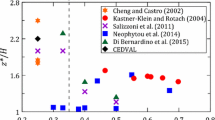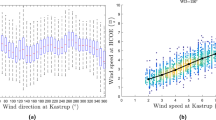Abstract
The purpose of this study is to review and improve prediction models for wind speed ratios at pedestrian level with simplified urban canopies. We adopted an extensive database of velocity fields under various conditions for arrays consisting of cubes, slender or flattened rectangles, and rectangles with varying roughness heights. Conclusions are summarized as follows: first, a new geometric parameter is introduced as a function of the plan area index and the aspect ratio so as to express the increase in virtual density that causes wind speed reduction. Second, the estimated wind speed ratios in the range 0.05 < z/h < 0.3, where h is the building height, are consistent with those derived from the database to within an error of ±25%. Lastly, the effects of the spatial distribution of the flow were investigated by classifying the regions near building models into areas in front of, to the side of, or behind the building. The correlation coefficients between the wind speeds averaged over the entire region, and the front or side region values are larger than 0.8. In contrast, in areas where the influence of roughness elements is significant, such as behind a building, the wind speeds are weakly correlated.









Similar content being viewed by others
Abbreviations
- A N , B N :
-
Empirical constants in prediction models (subscript indicates authors)
- A(z) , a(z) , b(z):
-
Height-dependent empirical coefficients
- a M :
-
Attenuation coefficient in Eq. (3.4)
- H :
-
Actual building height in simulation domain (=1L – 3L)
- h :
-
Assumed building height (30 m for a ten-story, 15 m for a five-story, and 6 m for a two-story building)
- h av :
-
Average building height for nonuniform array
- h max :
-
Maximum building height for nonuniform array
- L :
-
Standard length (=25 m)
- l x :
-
Streamwise distance between two blocks
- n :
-
index number of power law for wind speed
- Re* :
-
Roughness Reynolds number (\( ={u}^{*}{z}_o/\nu \))
- T :
-
Time scale defined by \( H/{u}^{*} \)
- U :
-
Spatially averaged streamwise wind speed (subscript indicates defined height)
- u * :
-
Friction velocity
- u , v , w:
-
Wind velocity components in the x , y , z directions, respectively
- V :
-
Magnitude of spatially averaged wind velocity vector (subscript indicates defined height)
- w p :
-
Width of pedestrian space (=3.0 m)
- X , Y:
-
Streamwise and spanwise block lengths, respectively
- x , y , z:
-
Coordinates in the streamwise, transverse, and vertical directions, respectively
- z o :
-
Roughness length
- z p :
-
Pedestrian height (=1.5 m)
- α p :
-
Aspect ratio (\( ={\lambda}_f/{\lambda}_p \))
- α px , α py :
-
Streamwise and spanwise aspect ratios, respectively
- γ N :
-
Prediction model of wind speed ratio (subscript indicates authors)
- γ(z, ζ):
-
Proposed prediction model for wind speed ratio
- \( {\gamma}_{h_{av}} \) :
-
Wind speed ratio defined by h av
- \( {\gamma}_{h_{\max }} \) :
-
Wind speed ratio defined by h max
- γfront , γ side , γ behind :
-
Wind speed ratio in pedestrian spaces
- λ f :
-
Frontal area index
- λ p :
-
Plan area index (=building coverage ratio)
- ν :
-
Dynamic viscosity
- ζ :
-
New geometric parameter [=\( 1-{\left(1-{\lambda}_p\right)}^{\alpha_p^{a(z)}} \)]
References
Cheng H, Castro IP (2002) Near wall flow over urban-like roughness. Bound-Layer Meteorol. 104:229–259
Cionco RM (1965) Mathematical model for air flow in a vegetative canopy. J Appl Meteorol 4:517–522
Coceal O, Thomas TG, Castro IP, Belcher SE (2006) Mean flow and turbulence statistics over groups of urban-like cubical obstacles. Bound-Layer Meteorol. 121:491–519
Deardorff JW (1980) Stratocumulus-capped mixed layers derived from a three-dimensional model. Bound-Layer Meteorol. 18:495–527
Hagishima A, Tanimoto J, Nagayama K, Meno S (2009) Aerodynamic parameters of regular arrays of rectangular blocks with various geometries. Bound-Layer Meteorol. 132:315–337
Hu T, Yoshie R (2013) Indices to evaluate ventilation efficiency in newly-built urban area at pedestrian level. J Wind Eng Ind Aerodyn 112:39–51
Ikeda Y, Hagishima A, Ikegaya N, Tanimoto J (2014) Estimation of wind speed of urban pedestrian spaces on a basis of large-eddy simulation. J. Environ. Eng. AIJ 80:709
Kanda M, Inagaki A, Gryschka M, Raasch S (2013) A new aerodynamic parameterization for real urban surfaces. Bound-Layer Meteorol. 148:357–377
Kubota T, Miura M, Tominaga Y, Mochida A (2008) Wind tunnel tests on the relationship between building density and pedestrian-level wind velocity. Build Environ 43:1699–1708
Letzel MO, Krane M, Raasch S (2008) High-resolution urban large-eddy simulation studies from street canyon to neighbourhood scale. Atmos Environ 42:8770–8784
Macdonald RW (2000) Modelling the mean velocity profile in the urban canopy layer. Bound-Layer Meteorol. 97:25–45
Mohammad A.F., Zaki S.A., Hagishima A., Ali M.S.M. (2014) Determination of aerodynamic parameters of urban surfaces: methods and results revisited, J. Theor. Appl Climatol, Published online.
Oke TR (1988) Street design and urban canopy layer climate. Energ Build 11:103–113
Razak AA, Hagishima A, Ikegaya N, Tanimoto J (2013) Analysis of airflow over building arrays for assessment for urban environment. Build Environ 59:56–65
Snyder WH, Castro IP (2002) The critical Reynolds number for rough-wall boundary layers. Wind Eng Indust Aerodyn 90:41–54
Stull RB (1988) An introduction to boundary layer meteorology. Springer
Wang W, Yi C (2012) A new nonlinear analytical model for canopy flow over a forested hill. J Theor Appl Climatol 109:549–563
Yoshie R, Tanaka H, Shirasawa T, Kobayashi T (2008) Experimental study on air ventilation in a built-up area with closely-packed high-rise buildings. J Environ Eng AIJ 73:661–667[in Japanese]
Yuan C, Ng E (2012) Building porosity for better urban ventilation in high-density cities—a computational parametric study. Build Environ 50:176–189
Zaki SA, Hagishima A, Tanimoto J, Ikegaya N (2011) Aerodynamic parameters of urban building arrays with random geometries. Bound-Layer Meteorol. 138:99–120
Acknowledgments
This work was supported by Japan Society for Promotion of Science KAKENHI Grant Numbers 25289196 and 25820282.
Author information
Authors and Affiliations
Corresponding author
Rights and permissions
About this article
Cite this article
Ikegaya, N., Ikeda, Y., Hagishima, A. et al. A prediction model for wind speed ratios at pedestrian level with simplified urban canopies. Theor Appl Climatol 127, 655–665 (2017). https://doi.org/10.1007/s00704-015-1655-z
Received:
Accepted:
Published:
Issue Date:
DOI: https://doi.org/10.1007/s00704-015-1655-z




